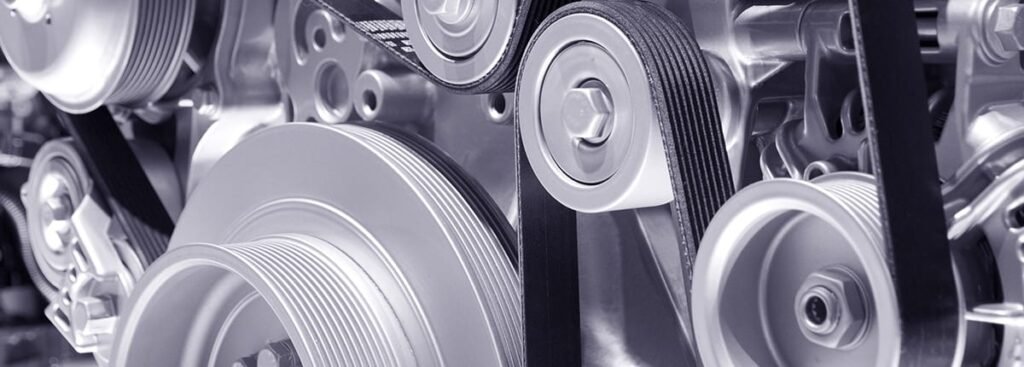
Replacing worn-out belts and hoses in your car is an essential maintenance task that ensures optimal performance and prevents serious damage to the engine.
Here’s a breakdown of what you need to know:
1. Signs of wear and tear
Squealing or chirping noises: Often indicates a loose or worn serpentine belt.
Visible cracks, fraying, or glazing (shiny surface): Signifies the belt has deteriorated and is at risk of snapping.
Engine overheating: Can be caused by a cracked or leaking hose that prevents proper coolant circulation.
Leaking fluids (coolant, power steering fluid, etc.): Points to a damaged hose that needs replacement.
Loss of power steering or air conditioning: May indicate a failing serpentine belt impacting these systems.
2. Types of belts and hoses
Serpentine belt: Powers major systems like the alternator, power steering pump, and air conditioning compressor.
Timing belt: Synchronizes the engine’s valves and pistons, crucial for engine function. Some vehicles use a timing chain instead.
Radiator hose: Carries coolant between the engine and the radiator.
Heater hose: Circulates coolant to the heater core for cabin heating.
Brake hose: Transports brake fluid to the braking system, vital for safety.
3. Recommended replacement intervals
Belts: Inspect monthly or with every oil change. Replace approximately every 50,000 miles or if there are 10 or more cracks in a one-inch section.
Timing belts: Replace every 60,000 to 100,000 miles or every 7 to 10 years, whichever comes first.
Hoses: Inspect every three months or with every oil change. They generally last between 50,000 and 100,000 miles.
4. Professional help vs. DIY
Serpentine belt replacement: Can be a relatively straightforward DIY task for someone with mechanical experience and basic tools, but may require expertise depending on the vehicle.
Timing belt replacement: Best left to experienced mechanics due to the risk of significant engine damage if done incorrectly.
Hose replacement: Inspecting and replacing some hoses can be a DIY job, but consulting a professional is advisable if unsure
5. Cost considerations
Timing belt replacement: Can range from $500 to $1,000 or more, with labor being a significant portion.
Serpentine belt replacement: Typically costs around $109 to $134, including parts and labor.
Important note: Always check your vehicle’s owner’s manual for specific maintenance recommendations and consult with a qualified mechanic if you’re uncertain about any repair or replacement task.
Besides mileage, what other factors affect belt and hose lifespan?
Mileage is a major factor in the lifespan of your car’s belts and hoses, but it’s not the only one. Here are some other factors that can significantly impact how long these components last:
1. Vehicle age
As a car ages, the rubber and other materials in belts and hoses naturally degrade, regardless of how much it’s driven.
Over time, they can become brittle, lose elasticity, and are more susceptible to cracking and leaks.
2. Extreme temperatures
Exposure to high temperatures, especially from the engine compartment, can accelerate the wear and tear of belts and hoses.
Cold temperatures can also make rubber stiffer and more prone to cracking, especially during a cold start.
3. Driving conditions
Harsh environments: Driving in areas with high levels of dust, dirt, or road debris can introduce contaminants that accelerate wear and tear.
Stop-and-go driving: Frequent stopping and starting puts more stress on belts and hoses, leading to faster deterioration.
Towing heavy loads: The added strain from towing can also shorten the lifespan of these components.
4. Exposure to fluids
Oil, coolant, and other automotive fluids can deteriorate the rubber and composite materials in belts and hoses if they come into contact with them frequently.
Leaks should be addressed promptly to prevent further damage to these components.
5. Belt tension
Maintaining proper belt tension is crucial for optimal performance and longevity.
Too loose: A loose belt can slip, reduce efficiency, and cause premature wear.
Too tight: Excessive tension can put undue stress on pulleys and bearings, leading to faster deterioration.
Most modern vehicles have automatic tensioners, but these can also fail and require attention.
6. Failed hose clamps
Loose or corroded hose clamps can cause leaks and allow the hose to detach, leading to a loss of fluids and potential engine damage.
7. Electrochemical degradation (ECD)
This process, caused by the breakdown of materials due to electrical current in the coolant, can weaken hoses from the inside out.
Hoses affected by ECD might feel soft or spongy at the ends, or have a “gappy” feel when squeezed, according to CarParts.com.
8. Maintenance history
Regular inspections and timely replacements, as recommended by the manufacturer, can significantly extend the lifespan of belts and hoses.
Ignoring warning signs like noises, cracks, or leaks can lead to further damage and potentially more costly repairs.
By considering these factors and performing regular inspections and maintenance, you can help ensure your car’s belts and hoses last as long as possible and prevent unexpected breakdowns.
